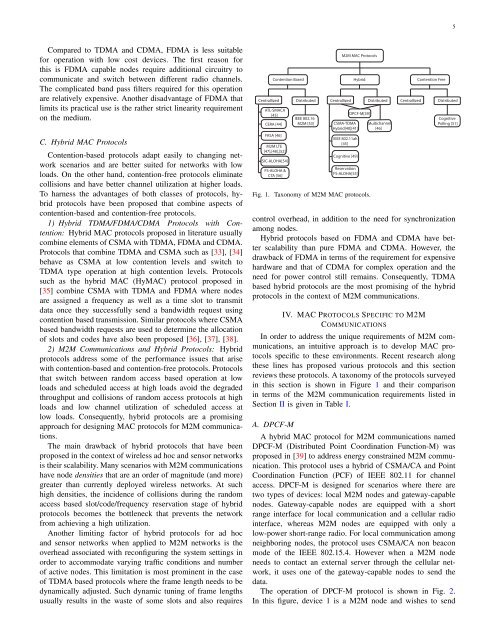survey-mac-layer
Create successful ePaper yourself
Turn your PDF publications into a flip-book with our unique Google optimized e-Paper software.
5<br />
Compared to TDMA and CDMA, FDMA is less suitable<br />
for operation with low cost devices. The first reason for<br />
this is FDMA capable nodes require additional circuitry to<br />
communicate and switch between different radio channels.<br />
The complicated band pass filters required for this operation<br />
are relatively expensive. Another disadvantage of FDMA that<br />
limits its practical use is the rather strict linearity requirement<br />
on the medium.<br />
C. Hybrid MAC Protocols<br />
Contention-based protocols adapt easily to changing network<br />
scenarios and are better suited for networks with low<br />
loads. On the other hand, contention-free protocols eliminate<br />
collisions and have better channel utilization at higher loads.<br />
To harness the advantages of both classes of protocols, hybrid<br />
protocols have been proposed that combine aspects of<br />
contention-based and contention-free protocols.<br />
1) Hybrid TDMA/FDMA/CDMA Protocols with Contention:<br />
Hybrid MAC protocols proposed in literature usually<br />
combine elements of CSMA with TDMA, FDMA and CDMA.<br />
Protocols that combine TDMA and CSMA such as [33], [34]<br />
behave as CSMA at low contention levels and switch to<br />
TDMA type operation at high contention levels. Protocols<br />
such as the hybrid MAC (HyMAC) protocol proposed in<br />
[35] combine CSMA with TDMA and FDMA where nodes<br />
are assigned a frequency as well as a time slot to transmit<br />
data once they successfully send a bandwidth request using<br />
contention based transmission. Similar protocols where CSMA<br />
based bandwidth requests are used to determine the allocation<br />
of slots and codes have also been proposed [36], [37], [38].<br />
2) M2M Communications and Hybrid Protocols: Hybrid<br />
protocols address some of the performance issues that arise<br />
with contention-based and contention-free protocols. Protocols<br />
that switch between random access based operation at low<br />
loads and scheduled access at high loads avoid the degraded<br />
throughput and collisions of random access protocols at high<br />
loads and low channel utilization of scheduled access at<br />
low loads. Consequently, hybrid protocols are a promising<br />
approach for designing MAC protocols for M2M communications.<br />
The main drawback of hybrid protocols that have been<br />
proposed in the context of wireless ad hoc and sensor networks<br />
is their scalability. Many scenarios with M2M communications<br />
have node densities that are an order of magnitude (and more)<br />
greater than currently deployed wireless networks. At such<br />
high densities, the incidence of collisions during the random<br />
access based slot/code/frequency reservation stage of hybrid<br />
protocols becomes the bottleneck that prevents the network<br />
from achieving a high utilization.<br />
Another limiting factor of hybrid protocols for ad hoc<br />
and sensor networks when applied to M2M networks is the<br />
overhead associated with reconfiguring the system settings in<br />
order to accommodate varying traffic conditions and number<br />
of active nodes. This limitation is most prominent in the case<br />
of TDMA based protocols where the frame length needs to be<br />
dynamically adjusted. Such dynamic tuning of frame lengths<br />
usually results in the waste of some slots and also requires<br />
Centrallized<br />
Contention Based<br />
ATL-SMACA<br />
[43]<br />
CERA [44]<br />
FASA [46]<br />
M2M LTE<br />
[47],[48],[52]<br />
SIC-ALOHA[54]<br />
FS-ALOHA &<br />
CTA [56]<br />
Distributed<br />
IEEE 802.16<br />
M2M [53]<br />
Centrallized<br />
M2M MAC Protocols<br />
Hybrid<br />
DPCF-M[39]<br />
CSMA-TDMA<br />
Hybrid[40][41]<br />
IEEE 802.11ah<br />
[45]<br />
Cognitive [49]<br />
Reservation<br />
FS-ALOHA[55]<br />
Fig. 1. Taxonomy of M2M MAC protocols.<br />
Distributed<br />
Multichannel<br />
[46]<br />
Centrallized<br />
Contention Free<br />
Distributed<br />
Cognitive<br />
Polling [51]<br />
control overhead, in addition to the need for synchronization<br />
among nodes.<br />
Hybrid protocols based on FDMA and CDMA have better<br />
scalability than pure FDMA and CDMA. However, the<br />
drawback of FDMA in terms of the requirement for expensive<br />
hardware and that of CDMA for complex operation and the<br />
need for power control still remains. Consequently, TDMA<br />
based hybrid protocols are the most promising of the hybrid<br />
protocols in the context of M2M communications.<br />
IV. MAC PROTOCOLS SPECIFIC TO M2M<br />
COMMUNICATIONS<br />
In order to address the unique requirements of M2M communications,<br />
an intuitive approach is to develop MAC protocols<br />
specific to these environments. Recent research along<br />
these lines has proposed various protocols and this section<br />
reviews these protocols. A taxonomy of the protocols <strong>survey</strong>ed<br />
in this section is shown in Figure 1 and their comparison<br />
in terms of the M2M communication requirements listed in<br />
Section II is given in Table I.<br />
A. DPCF-M<br />
A hybrid MAC protocol for M2M communications named<br />
DPCF-M (Distributed Point Coordination Function-M) was<br />
proposed in [39] to address energy constrained M2M communication.<br />
This protocol uses a hybrid of CSMA/CA and Point<br />
Coordination Function (PCF) of IEEE 802.11 for channel<br />
access. DPCF-M is designed for scenarios where there are<br />
two types of devices: local M2M nodes and gateway-capable<br />
nodes. Gateway-capable nodes are equipped with a short<br />
range interface for local communication and a cellular radio<br />
interface, whereas M2M nodes are equipped with only a<br />
low-power short-range radio. For local communication among<br />
neighboring nodes, the protocol uses CSMA/CA non beacon<br />
mode of the IEEE 802.15.4. However when a M2M node<br />
needs to contact an external server through the cellular network,<br />
it uses one of the gateway-capable nodes to send the<br />
data.<br />
The operation of DPCF-M protocol is shown in Fig. 2.<br />
In this figure, device 1 is a M2M node and wishes to send



